Article's Content
There are few moments that better showcase the benefit of investing in content than a B2B rebrand.
Domain name changes and site migrations are notoriously tricky on the organic front, so it’s worth noting when a company gets it right. For this week’s breakdown, that company is Guild.
Founded in 2015 as Guild Education, they were on a mission to provide post-secondary education to the workforce of large employers such as Walmart and Disney. That mission earned them $643.2 million in funding and a multi-billion-dollar valuation. But last year, the company realized there was room for growth beyond tuition reimbursement.
The team at Guild Education decided to undertake a major rebrand and site migration — a bold move during one of the most volatile periods in the history of organic search. Today, we’ll look at how they mitigated this volatility by investing heavily in content.
Let the education begin.
How Guild Is Carving Out Space Beyond EdTech with a Rebrand
The old saying “don’t get too big for your britches” applies to a lot of things, but SaaS is not one of them. Actually, one might argue it’s the goal. That’s what we see with the company’s transition away from the Guild Education brand and domain name to the more open-ended Guild.
The decision to change a brand name has plenty of implications and is never taken lightly – particularly for a company that raised $643 million in venture capital to unlock continuing education for employees. Central to the platform was establishing connections with large companies and colleges. You know, the education part of Guild Education.
To kick off their expansion from education reimbursement to career mobility, they started with a logo design change.

The Guild team partnered with two agencies to bring in branding and design experts. In a press release last summer, the team outlined the rationale behind this major rebrand. Here’s a TL;DR:
- Economic Factors: Talent shortages and skills gaps are making it difficult for people to reach the middle class through economic mobility.
- Rebrand: There are many ways to upskill employees beyond traditional education (they call them “Learners”), and Guild wants to encourage those as well.
- Segmentation: Many of the employees at companies with access to Guild are more interested in upskilling than learning.
- Go-to-Market: Guild used the rebrand to launch their Career Accelerator product, which provides self-serve access to resources (personalized learning).
Here’s how Rebecca Biestman, Guild’s CMO, put the significance of this transformation:
The rebrand makes sense to me. Why turn your own brand name into a shackle that ties you to just one niche?
In fact, we’ve seen a number of SaaS companies execute rebrands for this very reason. Here are a few of the ones we’ve covered recently:
- TripAction’s rebrand to Navan let them become more than just a pure travel expensing platform, moving into the wider expense management space.
- Miro moved away from the name RealTimeBoard to propel the entire digital collaboration industry with their 11-figure valuation.
- Transferwise dropped the “Transfer” during their rebrand to expand beyond simple payment transfers and become full-fledged FinTech giant Wise.
Then there are the not-so-straightforward situations, like what we saw play out with WooCommerce over the past year. The company switched over to a new domain, woo.com, only to switch back to the original, woocommerce.com, less than a year later. Apparently, the Google SERPs for “Woo” were a little too crowded for their liking.
Thus far, all indications point to a more successful (and permanent) transformation for Guild.
Navigating a Major Rebrand and Site Migration
It’s easy to get caught up in the storm of creativity that a successful rebrand requires (especially if you love brand marketing). But there’s another major element to this transformation that demands focus — the domain change.
Dropping the Education from the Guild brand name is one thing. Removing it from the company URL is another. Rebrands involving a domain migration can have a wide-ranging impact on your website, affecting everything from keyword ranking and traffic dips to domain authority and page rank.
Stress levels surrounding rebrands and migrations are on the rise. Interestingly, so are frustrations with Google due to SERP volatility and major traffic drops.
Adam Riemer recently summed up the SEO risks of these initiatives on Search Engine Land, saying:
“Changing code bases with a new name and URL means search engines must discover the new brand, evaluate it, and determine the new user experience. Now, they evaluate how it stacks up to other pages in their indexes. Chances are you’ll lose a bit, even if it is the best, because you’re shocking the system too much.”
It’s still possible to successfully conduct a rebrand and migration (especially if you have enterprise resources). For instance, Fabrizio Ballarini, Head of Growth at Wise, outlined some of the key tactics his team used to successfully navigate the Transferwise rebrand:
- Phase the migration by running the two domains simultaneously to minimize the risk.
- Dedicate SEO personnel to updating the schema markups and technical site health.
- Maintain a clear redirect strategy to ensure that they maintain the SEO value of current URLs.
- Focus on non-branded traffic growth to get a clear picture of organic search performance.
- Invest in new educational resources to build long-term organic traffic and customer acquisition.
So, while the risk that rebrands pose to key organic metrics seems to be increasing, there are definite steps that brands can take to mitigate it.
Here’s a look at how the average organic traffic and number of organic pages changed for the Guild Education domain in the years before the April 2023 transition.
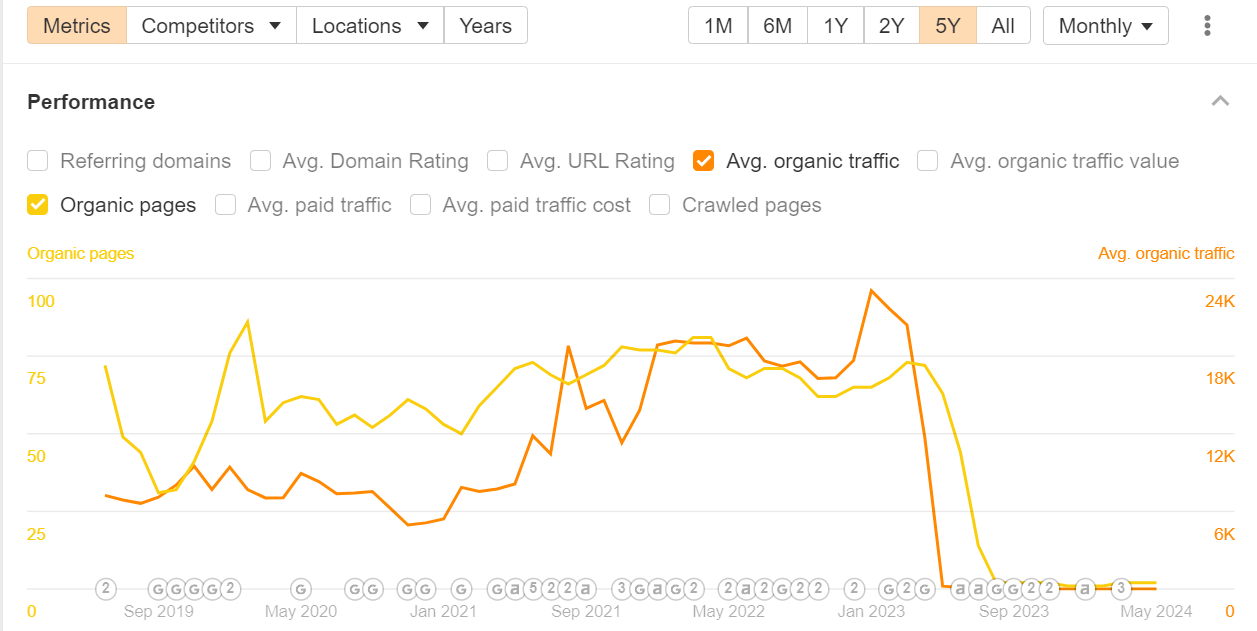
With the Guild team setting up the new domain a month earlier in March 2023, the number of pages on the Guild Education domain dropped from just over 70 in April to just two pages in August. It took just two months to set up the new site structure, publish 86 pages, and propel organic visits up to 22,000 by May. By June, the new domain had backlinks from nearly 1,300 referring sites — a few hundred more than they had before the rebrand.
Guild clearly takes their SEO seriously. Madison Canon, Senior Digital, Content, and SEO Marketing Manager, and the rest of the team checked off the first three boxes of Ballarini’s rebrand advice:
✅Phase the migration by running two domains simultaneously.
✅Dedicate resources to schema markups and technical site health.
✅Maintain the value of URLs with a redirect strategy.
Interestingly, the new Guild domain did experience a significant traffic drop at the end of 2023. Organic visits plummeted from around 20,000 to 6,500 in December, but this quickly corrected as they added hundreds of pages to the new domain. The organic traffic numbers now sit at around 26,000 monthly visits.
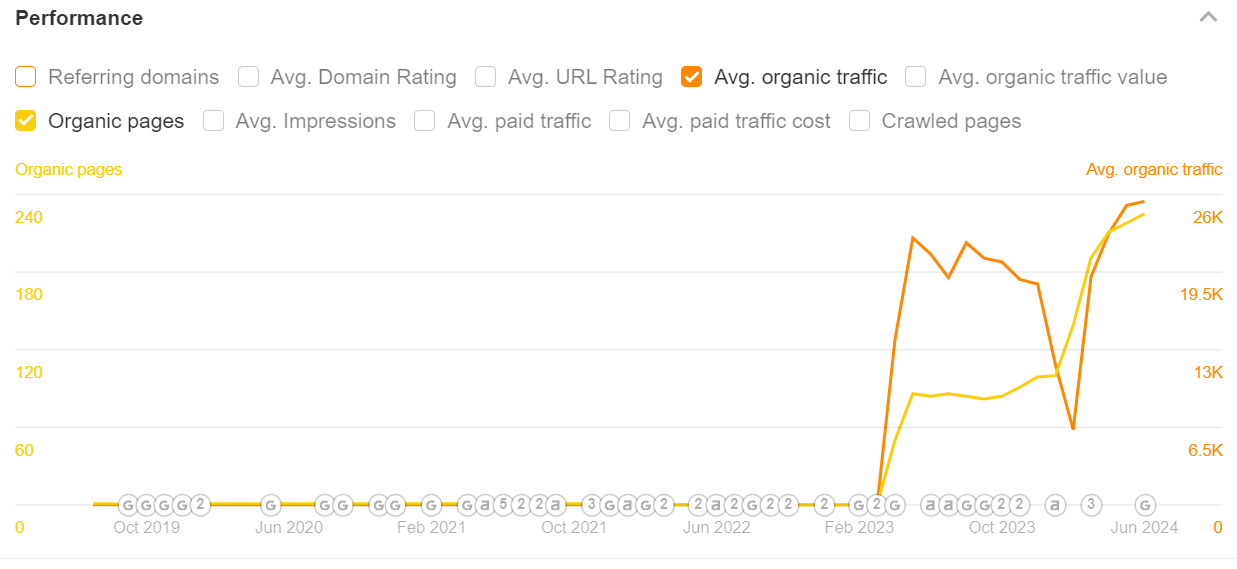
The Guild team has added 111 pages to their new domain over the past six months, starting in January 2024. So far, this seems to be an effective strategy for mitigating post-rebrand volatility (at least so far). It looks like Ballarini and the Wise team were right — investing in content is a key component to navigating a rebrand.
Now, we just have to answer one question: What type(s) of content did they invest in?
Driving the Chance of Success with Content Investment
Across both B2C and B2B, rebrands typically come alongside a go-to-market launch of some kind. Whether it’s the launch of a new physical product or an expanded service offering, content plays a crucial role in driving success. Guild’s approach to content creation post-rebrand exemplifies this strategy.
Content Investment Breakdown
The Guild content team has been busy in 2024. Over the past six months, they’ve taken a moderate growth approach to asset allocation, going beyond validated SEO to cover a number of growth keywords and spread thought leadership.
Here’s a breakdown of 101 of the pages that Guild added this year in terms of subfolders and asset types:
- News and press (+19 pages): The news and press subfolder is a space for Guild to announce major updates and also curates coverage from prominent brands like Fortune, Forbes, and Employee Benefits News. It’s a steady stream of fresh, relevant content.
- Compass (+17 pages): This monthly publication/subfolder/newsletter is a “go-to source for inspiration in the HR space”. The subfolder on Guild’s site is full of HR-specific thought leadership pieces exploring everything from upskilling workforces with AI to managing the burnout crisis.
- Report (+16 pages): These in-depth reports, e-books, and other downloadable assets cover topics such as industry workforce trends, the ROI of education, and specific career mobility pathways.
- Event (+11 pages): These short assets include sign-up pages for upcoming Guild webinars and lead-capture forms in exchange for access to previous ones.
- Member resources (+8 pages): This subfolder is dedicated to Guild’s beneficiaries, the employees at large companies. It contains actionable articles on topics like coaching and mentorship, goal setting, and embracing new technology.
- Case study (+8 pages): These downloadable assets include stats and testimonials on the benefits that major employers such as Walmart, Chipotle, and Bon Secours Mercy Health gain from upskilling their workforce with Guild.
- Video (+6 pages): These pages repurpose video content by embedding YouTube videos, including interviews with Guild executives, education leaders, and the employees benefiting from access to Guild.
- Career mobility (+5 pages): This subfolder contains a cluster of pages with long-form breakdowns specific to career mobility and related topics. The content aligns with Guild’s expanded focus post-rebrand and allows them to capture a growth SEO topic (more on this later).
- Education benefits (+4 pages): This is another cluster subfolder that covers the major benefits of an educated workforce and the key tactics for achieving that at large organizations.
- Opportunity employer (+4 pages): Like the career mobility and education benefits subfolder, this growing topic cluster focuses on the role opportunity employers play in equitable talent development.
- Latest insights (+3 pages): This mishmash of timely, relevant content includes the latest HR industry trends, thought leadership on upskilling, and the benefits of Guild’s Career Accelerator tool.
This diverse content mix tells you that the Guild team is committed to providing value across various touchpoints in the customer journey, from awareness to consideration and decision-making. The pace of production, well past the benchmark of 100 new pages for the year, bodes very well for future organic growth.
It’s worth noting that among the top pages bringing in organic traffic through non-branded keywords, five of the top six were created in 2024. These new pages represent just over 500 monthly visits, but the results will compound if Guild continues to build out their SEO moat by investing in different content types.
Key Content Strategies Driving Guild’s Growth
from the outside, it can be difficult to see the method behind the madness when sifting through over 100 new assets. But that’s the beauty of an enterprise content marketing strategy: It helps you organize what appears to be “run-of-the-mill” content into a funnel that drives new business. Guild is starting to see the fruits of that labour now, but the planning was months (probably years) in the making.
Covering the entirety of the strategy would require its own subfolder. So, to close out this piece, I’ll focus on some of the specific tactics that Guild uses to drive organic traffic post-rebrand.
Growth SEO Topic Clusters
One of the most effective ways to capture a keyword you want — and ensure value to the reader — is to write a long-form piece of content about it. Then, you link to that topic from other assets that focus on related long-tail and semantic variations. Some call it spoke and wheel, some call it pillar pages, and some call it topic clusters.
Whichever name you prefer, it all refers to a specific approach to capturing a search term. And remember: Capturing non-branded traffic is one of the keys to coming out strong from a rebrand or site migration.
As I mentioned earlier, Guild is investing heavily in content around career mobility, creating a subfolder, complete with a dedicated landing page and PDF download, to target this crucial keyword. Over the past six months, their content team has added five more assets to this subfolder, targeting the following keywords:
- Lateral move vs. vertical move
- Career mobility definition
- Career mobility platform
- Career mobility mentorship
- Career mobility strategies
This brings the career mobility subfolder to a total of nine dedicated pages on the topic, each of which links to that central career mobility page. As of now, the subfolder has earned Guild 229 keywords, including a top-3 position for 16 career mobility–related keywords.
The cluster page focusing on different types of career mobility, which already brings in over 215 monthly visits, perfectly illustrates the level of detail Guild puts into these cluster assets:
- Covering the topic of lateral vs. vertical career growth completely, with over 3,500 words of clear, concise copy.
- Creating a user-friendly, easy-to-navigate page with a table of contents and chapter structure that summarizes the content in each subsection.
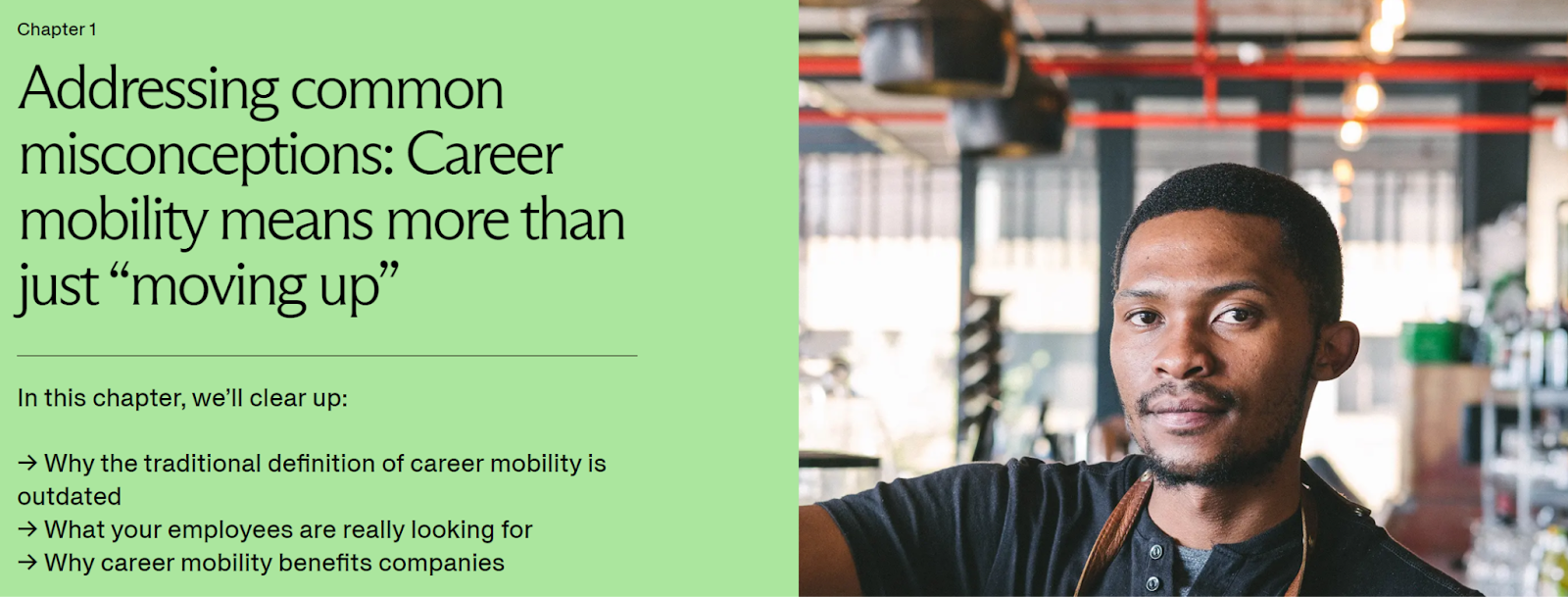
- Maximizing the amount of time readers spend on the Guild site by interlinking to over 40 different pages across the domain.
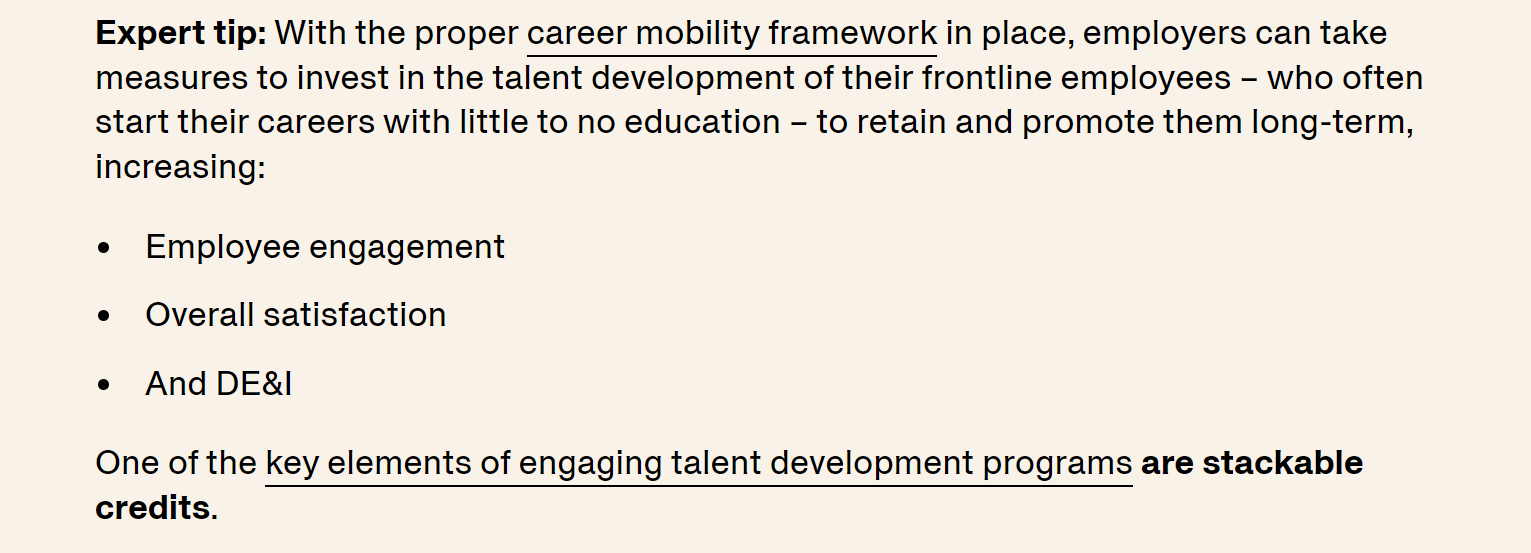
- Leveraging the massive store of anonymized internal data contained in the Guild platform to provide insights into the state mobility

- Driving leads to gated assets and demo signups with strategic CTAs and links guiding interested readers to relevant content.

This is a great strategy for securing and maintaining a top spot for “career mobility” — a term that Guild currently ranks 5th for on the Google SERP. Considering the term currently gains around 600 monthly searches and has a very low keyword difficulty, I’d expect Guild to continue to climb up the ranks for this query and related terms. And remember: Guild uses a similar playbook for “opportunity employer” and “education benefits.”
Topic clusters, especially ones that are built into the structure of a website, are not as common as they should be. When used effectively, these clusters turn into major traffic magnets. NerdWallet is one SaaS brand that’s masterfully executed this strategy.
Compass: HR-Focused Publication
The asset type that Guild has invested in the most over the past six months is the News and Press subfolder. It makes sense. They want to spread the word about the new brand, visions, and company offering as much as possible. Guild has added 19 pages to this subfolder already.
But it’s the next most popular subfolder — Compass — that I want to end on.
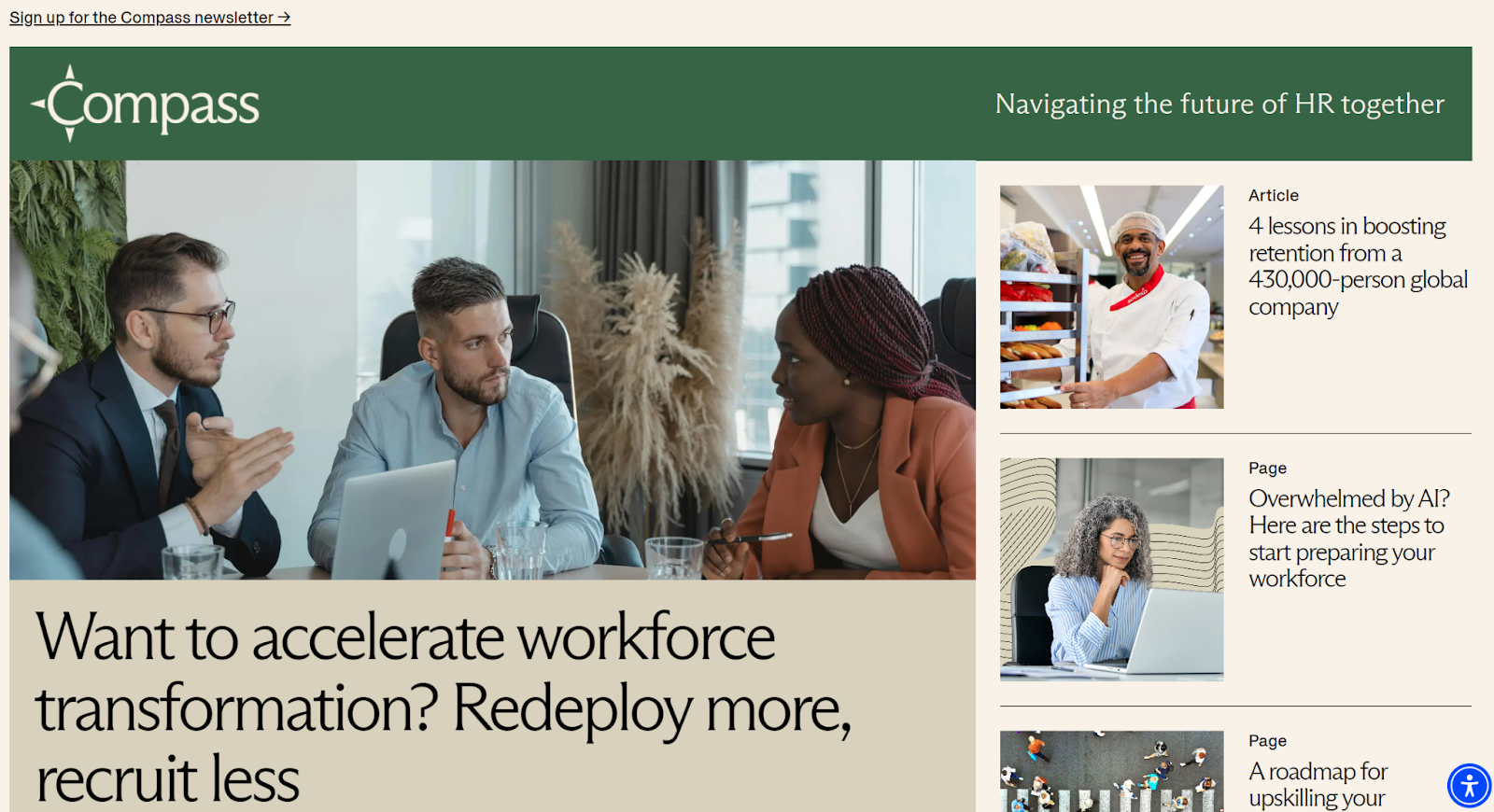
Guild has added 17 pages to their branded publication centered around “navigating the future of HR together” over the past four months. That’s a significant investment, especially since the subfolder has minimal traffic at the moment. But that shouldn’t be a major concern for their marketing team.
Why? Because Compass is a long-term play.
The Compass subfolder is a worthwhile investment for Guild because it positions the company as a thought leader on the cutting edge of trends and bold ideas, reshaping the HR landscape in 2024 and beyond. By focusing on topics like the transformative impact of AI, Compass content demonstrates that Guild has their finger on the pulse of the most disruptive forces in the world of work.
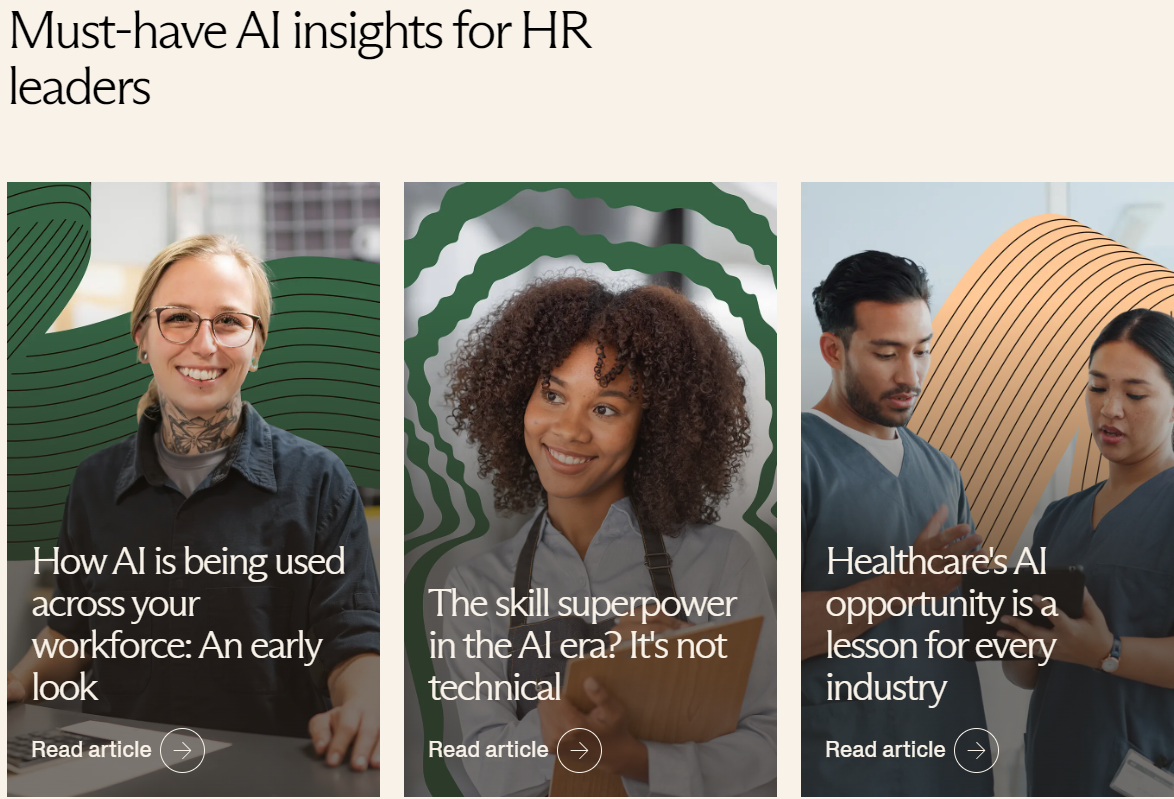
By diving deep into subjects like managing the impact of generative AI, bridging AI skills gaps, and integrating AI into workforce planning, Compass provides HR decision-makers with valuable insights and guidance they can’t find elsewhere.
The emphasis on “big bets” and bold ideas in Compass content also helps differentiate Guild as a source of visionary thinking and thought leadership, not just tactical advice. Pieces on reimagining productivity, championing sustainability, and enabling career mobility show that Guild is looking beyond the day-to-day to shape the future of work. This aspirational content will resonate with forward-thinking HR leaders and position Guild as their ideal partner in navigating change.
By establishing itself as an authority on the trends that matter most, Compass can attract HR changemakers to Guild’s platform as they seek to stay ahead of the curve. Over the coming months and years, this subfolder can create a vital pipeline of engaged, inspired leads that can eventually convert to Career Accelerator users and employer partners.
That’s the power of high-quality content.
Protect Your Online Real Estate with Great Content
Take it from Guild — rebrands are about so much more than a name change, new visuals, and domain migration. With SERP volatility at an all-time high, a sophisticated content strategy is key to reducing traffic loss post-rebrand.
By diversifying their content types, focusing on key topics like career mobility and opportunity employment, and establishing thought leadership through publications like Compass, Guild is effectively building an SEO moat that helps turn readers into long-term customers.
The company’s investment in high-quality, targeted content across various subfolders shows a commitment to providing value at every stage of the customer journey. As they continue to invest in this strategy, the compounding effects are likely to drive significant organic growth in the coming years, solidifying Guild’s position as a leader in the career development and workforce education space.
If you have a rebrand or site migration on the horizon and need help mitigating the potential damage or just want to protect your SERP position, get in touch today.







